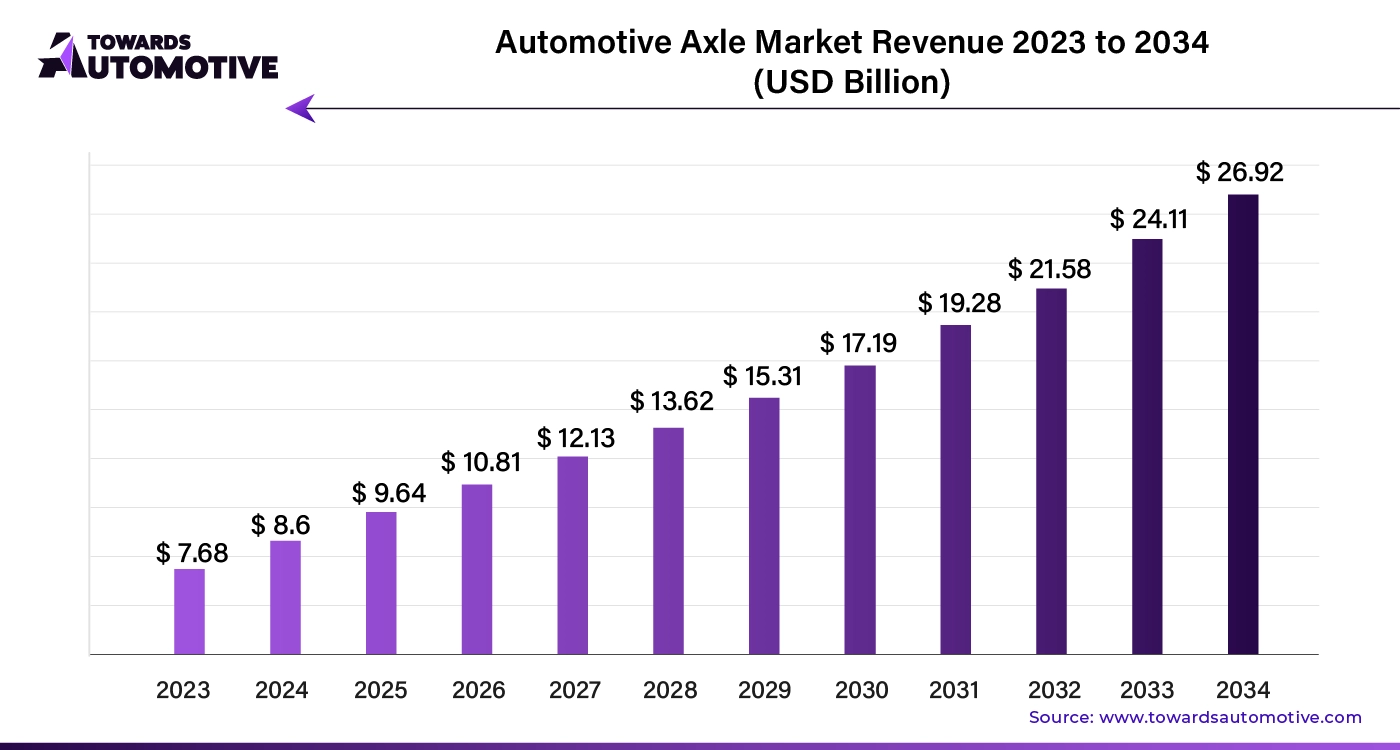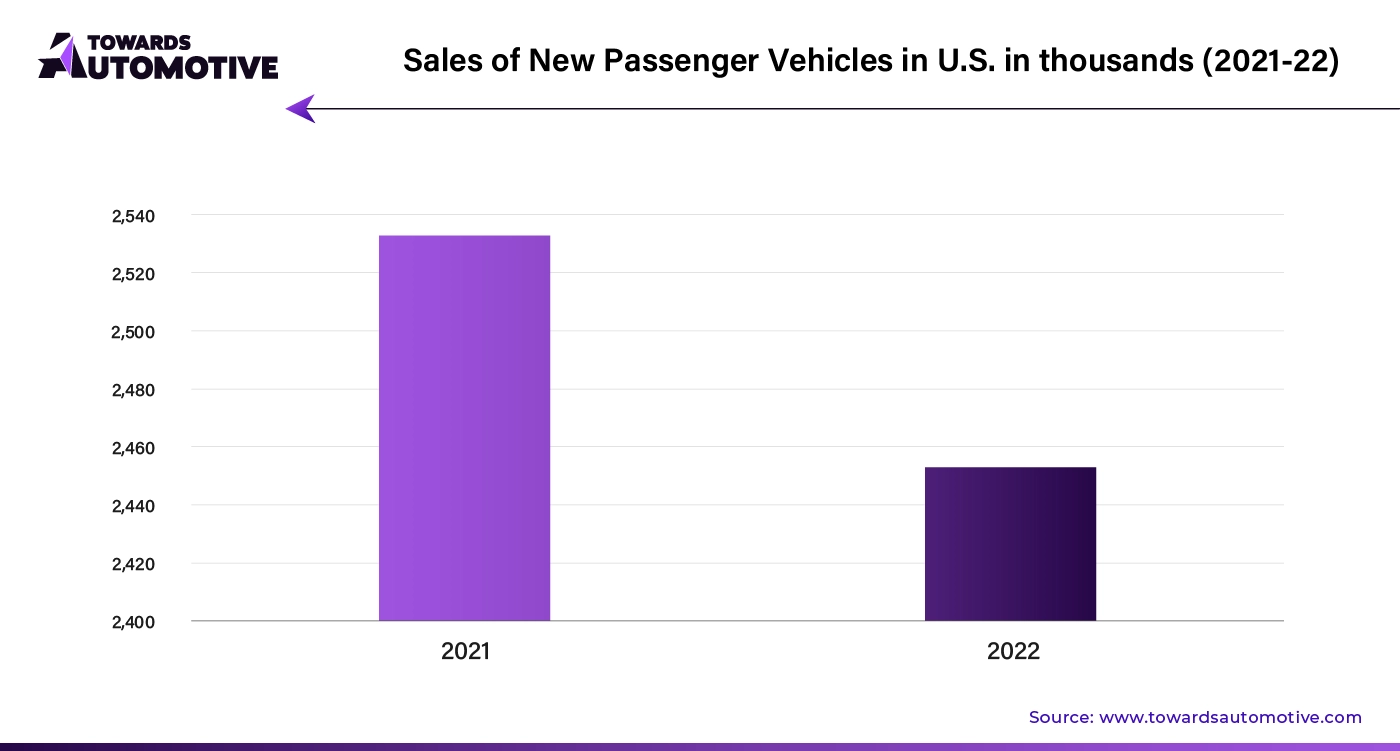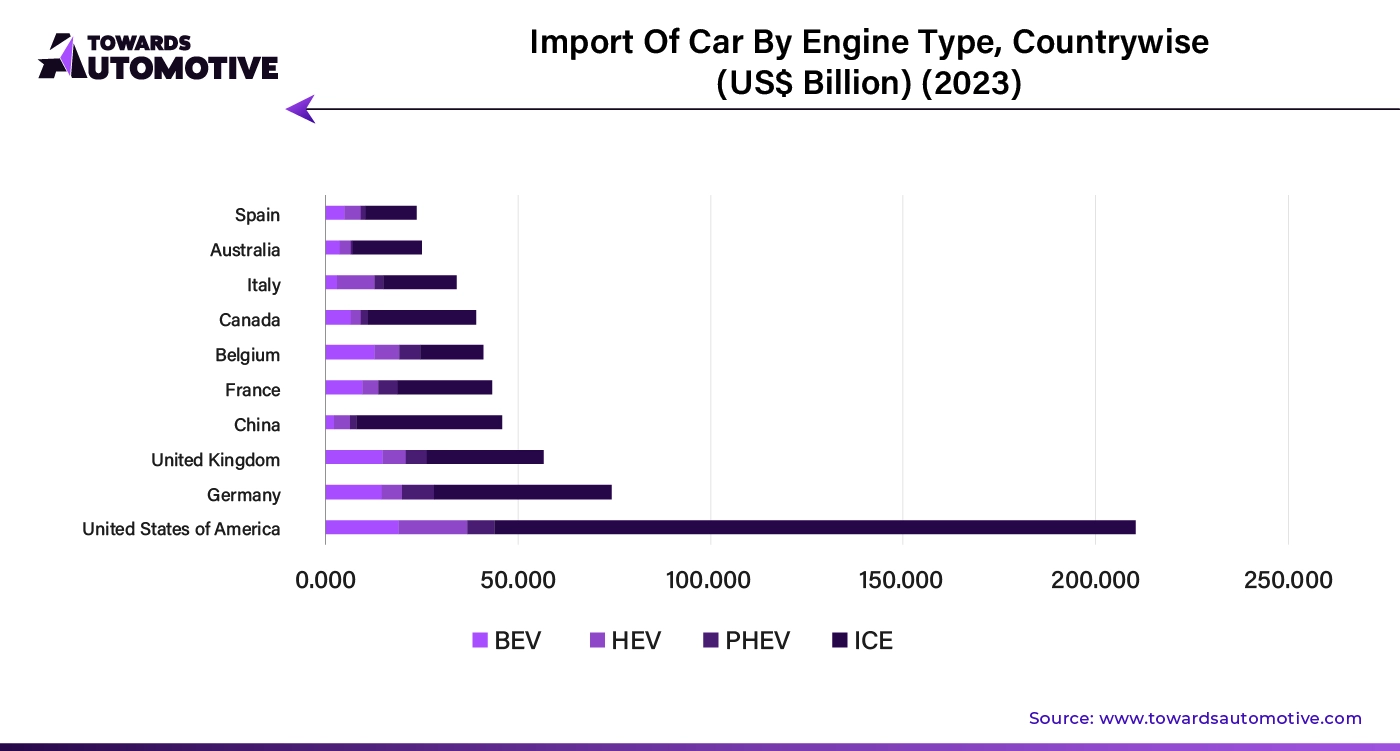August 2025
The global automotive axle market size is calculated at USD 8.6 billion in 2024 and is expected to be worth USD 26.92 billion by 2034, expanding at a CAGR of 12.15% from 2024 to 2034.

Unlock Infinite Advantages: Subscribe to Annual Membership
Artificial Intelligence (AI) is playing a transformative role in the automotive axle market by enhancing design, manufacturing, and maintenance processes. In the design phase, AI-driven simulations and predictive analytics enable engineers to optimize axle performance and durability by analyzing various load conditions and materials. This leads to more efficient and innovative designs that meet the evolving needs of modern vehicles. During manufacturing, AI enhances precision and quality control through advanced machine learning algorithms that monitor production processes in real time, reducing defects and waste.
Predictive maintenance is another critical application of AI; by analyzing data from vehicle sensors, AI can forecast potential axle failures or maintenance needs before they occur, thereby extending axle life and improving vehicle reliability. Additionally, AI supports the development of lightweight axles by optimizing material use and structural integrity through computational methods. As electric and autonomous vehicles become more prevalent, AI helps in designing axles that integrate seamlessly with new powertrains and advanced driver-assistance systems (ADAS).
Overall, AI is driving significant advancements in the automotive axle market, enabling more efficient production, improved performance, and enhanced vehicle safety. The automotive market valued at USD 4,070.19 billion in 2023, is experiencing growth and is projected to surpass USD 6,678.28 billion by 2032, with a significant CAGR of over 5.66%.
The automotive axle market is a vital segment within the global automotive industry. This industry is integral to vehicle performance, safety, and efficiency. Axles are crucial components that support the vehicle’s weight, enable wheel rotation, and transfer power from the engine to the wheels. As a key element in vehicle drivetrains, axles significantly impact handling, stability, and ride comfort. The market encompasses various types of axles, including front, rear, and drive axles, tailored for diverse vehicle categories ranging from passenger cars to commercial trucks and buses.
Recent trends in the automotive axle market are boosted by technological advancements and evolving consumer demands. Innovations such as lightweight materials, electric and hybrid vehicle adaptations, and enhanced durability are reshaping the market landscape. Additionally, the rise in vehicle production, coupled with increasing vehicle ownership globally, fuels the demand for advanced axle systems.
Emerging markets and a growing focus on improving fuel efficiency and reducing emissions further influence market dynamics. As the automotive industry continues to evolve, the axle market remains pivotal in supporting both traditional and next-generation vehicle technologies. Understanding these trends and developments is crucial for stakeholders aiming to navigate the complexities of this essential automotive component market.
Increased Demand for Light Weight Wheel Axle
Lightweight automotive axles are revolutionizing the automotive axles market by addressing critical demands for enhanced vehicle efficiency and performance. As the automotive industry increasingly prioritizes fuel efficiency and reduced emissions, lightweight axles have become a focal point for innovation. Traditional axles, often constructed from heavy steel, contribute to a vehicle's overall weight, which in turn impacts fuel consumption and driving dynamics. In contrast, lightweight axles, made from advanced materials such as aluminum alloys, composite materials, and high-strength steels, offer significant weight reductions without compromising strength or durability. This weight reduction leads to improved fuel efficiency, better acceleration, and enhanced handling, making them particularly attractive for both conventional and electric vehicles.
Increasing regulatory pressures for lower emissions and higher fuel economy standards are pushing manufacturers to seek out lighter, more efficient components. Additionally, the growing popularity of electric vehicles, which require efficient power delivery and weight management to maximize battery range, further accelerates the demand for lightweight axle solutions. Innovations in manufacturing processes and material technology are also contributing to the expansion of this segment. For instance, the use of carbon fiber-reinforced polymers in axle design is pushing the boundaries of weight reduction and performance. As the automotive industry continues to evolve, the integration of lightweight axles is set to play a crucial role in advancing vehicle technologies and meeting the stringent demands of modern transportation.
Numerous Challenges Forbid the Market Growth
The automotive axle market faces several challenges, including rising production costs due to the need for advanced materials and technologies. Regulatory pressures for stricter environmental and safety standards add to the financial burden on manufacturers. Additionally, the industry must adapt to rapid technological advancements, such as electric and autonomous vehicle integration, while managing global competition and ensuring axle durability and reliability. These issues collectively impact the market’s growth and operational efficiency.
Advancements in Carbon Fiber for Manufacturing Automotive Axle
The use of carbon fiber in automotive axle manufacturing represents a significant advancement in vehicle engineering, driven by the material's exceptional strength-to-weight ratio. Carbon fiber composites offer a notable reduction in weight compared to traditional metals like steel and aluminum, which leads to improved vehicle performance, enhanced fuel efficiency, and better handling. This weight reduction is particularly advantageous in high-performance and electric vehicles, where every kilogram saved contributes to greater acceleration and extended battery range. The high tensile strength and stiffness of carbon fiber also ensure that axles can withstand significant loads and stresses, maintaining durability and reliability even under demanding conditions. Additionally, the use of carbon fiber can improve vehicle dynamics by reducing weight, leading to better ride quality and handling characteristics. However, the integration of carbon fiber into axle manufacturing poses challenges, including higher material and production costs and the need for specialized manufacturing techniques. Despite these challenges, ongoing advancements in carbon fiber technology and decreasing costs are making it an increasingly viable option for high-performance and luxury vehicles. Overall, the adoption of carbon fiber in axle design is driving innovation and contributing to the development of more efficient and capable automotive systems. Thus, the development in carbon fiber for production of automotive axle is likely to create opportunities for the market players.
The passenger car segment held the largest share of the market with 56%. The passenger car segment is a significant driver of growth in the automotive axle industry due to increasing vehicle production and evolving consumer preferences. As global car ownership rises and urban mobility needs shift, there is a growing demand for innovative axle systems that enhance performance, safety, and comfort. Advances in vehicle technology, including the integration of electric and hybrid powertrains, are pushing the development of specialized axles that meet the requirements for efficiency and power distribution in these newer vehicle types.
Additionally, the push for improved fuel efficiency and reduced emissions has led to a demand for lightweight axles made from advanced materials such as aluminum and carbon fiber, which contribute to overall vehicle efficiency. Automakers are also focusing on improving ride quality and handling, which necessitates the development of more sophisticated axle designs. Furthermore, the rise in premium and high-performance passenger vehicles is driving demand for advanced axle systems that offer enhanced driving dynamics and durability. As passenger cars continue to evolve with new technologies and design innovations, the automotive axle industry is experiencing robust growth, driven by the need to meet these changing demands and deliver high-performance solutions.

The light commercial vehicles held a notable share of the market in 2023. Light Commercial Vehicles (LCVs) play a crucial role in driving the growth of the automotive axle market due to their widespread use in various industries, particularly in logistics and transportation. The rapid expansion of e-commerce and the rise in last-mile delivery services have significantly increased the demand for LCVs, which are preferred for their maneuverability and efficiency in urban environments. As these vehicles are essential for transporting goods, especially in congested areas, there is a growing need for durable and reliable axles that can support the increased loads and rigorous usage conditions.
Moreover, the proliferation of small and medium-sized enterprises (SMEs) that rely on LCVs for their operations has further fueled the demand for these vehicles, subsequently boosting the automotive axle market. The versatility of LCVs, which are used in various applications from goods transportation to passenger services, requires axles that offer high performance, durability, and adaptability. As manufacturers continue to innovate and improve axle designs to meet the specific needs of LCVs, the automotive axle market is expected to witness significant growth, driven by the rising global demand for efficient and reliable transportation solutions.
The drive axle segment dominated the market with a share of 70%. The drive axle plays a pivotal role in boosting the automotive axle industry by being a critical component that directly influences vehicle performance, efficiency, and safety. As the primary mechanism that transfers power from the engine to the wheels, the drive axle is essential for propulsion, making it indispensable in both passenger vehicles and commercial vehicles. With the increasing demand for vehicles with better fuel efficiency, higher payload capacities, and enhanced driving dynamics, there is a growing need for advanced drive axles that can meet these requirements.
The shift towards electric and hybrid vehicles has further accelerated innovations in drive axle technology. Electric vehicles, for instance, require specialized drive axles that can handle higher torque levels and operate efficiently with electric powertrains. Additionally, the rise of all-wheel-drive (AWD) and four-wheel-drive (4WD) systems in both light commercial and passenger vehicles has increased the demand for more sophisticated and durable drive axles. These trends are driving manufacturers to invest in research and development to create lighter, stronger, and more efficient drive axles. As a result, the automotive axle industry is experiencing significant growth, with the drive axle segment being a key contributor to this expansion.

The lift automotive axle held a significant share of the market in 2023. Lift axles hold significant importance in the automotive axle industry, particularly in commercial vehicles where flexibility and efficiency are paramount. These axles can be raised or lowered depending on the load requirements, offering advantages in fuel efficiency, tire wear reduction, and overall vehicle adaptability. In heavily loaded scenarios, the lift axle is engaged to distribute the weight more evenly, enhancing vehicle stability and safety. Conversely, when the load is lighter, the axle can be lifted to reduce drag and improve fuel economy.
The growing emphasis on sustainable transportation and cost-efficiency has driven the adoption of lift axles, especially in heavy-duty trucks and trailers. This trend has spurred demand for advanced, durable lift axle systems, contributing to the growth of the automotive axle industry. As fleet operators seek to optimize vehicle performance and reduce operating costs, the lift axle market segment is becoming an increasingly important driver of industry expansion.
North America dominated the market with a share of 33% in 2022. The automotive axle industry in North America is driven by several key factors, reflecting the region's dynamic automotive sector. One of the primary drivers is the robust demand for commercial vehicles, including trucks and light commercial vehicles (LCVs), fueled by the expanding logistics and e-commerce sectors. As companies prioritize efficient supply chain operations and last-mile delivery services, the need for durable and high-performance axles has surged, particularly in vehicles designed for heavy-duty applications.
Additionally, the growing consumer preference for SUVs and crossovers, which often feature advanced drivetrain systems like all-wheel-drive (AWD), has boosted demand for sophisticated axle systems. These vehicles require specialized axles that can handle diverse terrains and offer enhanced driving dynamics, further driving innovation in the axle market.
Moreover, the push towards electric and hybrid vehicles in North America is reshaping the automotive axle industry. The shift towards electrification demands lighter, more efficient axles that can support the unique requirements of electric powertrains, such as higher torque levels and regenerative braking systems. This trend is encouraging significant research and development investments, driving the market forward. Combined with stringent regulatory standards for fuel efficiency and emissions, these factors collectively contribute to the sustained growth of the automotive axle industry in North America.
Europe held the second largest share of the market with 28%. The automotive axle market in Europe is driven by several key factors, reflecting the region's commitment to innovation, sustainability, and stringent regulatory standards. A major driver is the European Union's rigorous emissions regulations, which have prompted automakers to focus on fuel efficiency and reducing vehicle weight. This has led to increased demand for lightweight and advanced axle systems that contribute to overall vehicle efficiency without compromising performance. Additionally, the rising popularity of electric and hybrid vehicles in Europe has accelerated the need for specialized axles that can handle the unique requirements of these powertrains, such as higher torque and integration with regenerative braking systems.
Europe's well-established automotive industry, known for its strong engineering capabilities, is also pushing the boundaries of axle technology. The region's leading automakers are investing heavily in research and development to create more durable, efficient, and adaptable axles, particularly for premium vehicles and commercial trucks. Furthermore, the growth of the commercial vehicle sector, driven by an expanding logistics industry and cross-border trade, is boosting demand for reliable axles capable of supporting heavy loads and long-distance travel. These factors, combined with a strong focus on sustainability and innovation, are key drivers of the automotive axle market in Europe.
By Axle Type
By Application
By Vehicle Type
By Region
August 2025
August 2025
August 2025
July 2025
We offer automotive expertise for market projections and customizable research, adaptable to diverse strategic approaches.
Contact Us